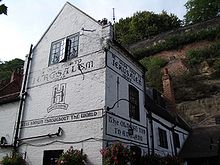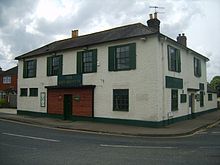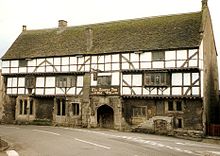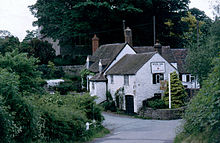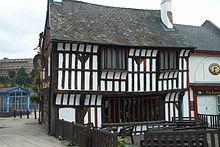- List of public houses in the United Kingdom
-
The following is a list of public houses in the United Kingdom.
Contents
England
- See Category:Public houses in England
East Anglia
- The Berney Arms in Norfolk may only be reached by foot, by boat or by train as there is no road access. It is served by the nearby Berney Arms railway station which likewise has no road access and serves only the pub and nearby nature reserves.
- The Eagle in Cambridge, the pub in which Francis Crick and James Watson announced that they had "discovered the secret of life" (the structure of DNA). It was also frequented by Alan Turing and friends.
- The Nutshell, Bury St Edmunds, Suffolk. Britain's smallest pub measuring just 5 metres by 2 metres (16.5 ft by 6.5 ft), according to the Guinness Book of Records.
East Midlands
- Ye Olde Trip To Jerusalem in Nottingham. It incorporates caves under Nottingham Castle and claims to be the oldest pub in the UK.
London
- The Blind Beggar, Whitechapel. Infamous for its association with the Kray twins.
- The Angel, Rotherhithe. Another claimant for the title of oldest Thames bank pub. Claims ancestry from an inn on a site nearby dating back to the 11th century.
- The Angel, Islington. Formerly a coaching inn, the first on the route northwards out of London, where Thomas Paine is believed to have written much of The Rights of Man, mentioned by Charles Dickens it became a Lyons Corner House, and is now a Co-operative Bank. It is also on the board in the British version of the board game Monopoly.
- The Armoury (formerly The Crane), Wandsworth. Built in 1748, though it is claimed and disputed that a public house existed on the site since Roman times. Meeting place of the Wandsworth Chartists.
- Booty's Riverside Bar,[1], Limehouse. Thames-side pub near Canary Wharf, London Docklands.
- Canonbury Tavern, Canonbury. Prototype for George Orwell's ideal English pub, The Moon Under Water.
- Crocker's Folly, Maida Vale. Huge ornate late Victorian pub, currently closed, said to have been built by Frank Crocker on this site in the expectation that the Great Central Railway terminus in London would be built opposite and not in Marylebone.
- De Hems - the primary Dutch pub in London.
- Dirty Dick's, Bishopsgate. Named after a local resident, recluse and dirty person. Parts of the building fabric precede the Great Fire of London.
- The Dove, Hammersmith. Definitely once the haunt of Ernest Hemingway and Graham Greene, it also claims the smallest bar in Britain (according to the Guinness Book of Records), though not to be the smallest pub. It also makes the disputed claim to be the oldest surviving Thames-side pub.
- The Drayton Court in Ealing, converted into a pub from a hotel in the 19th century.
- The Eagle, 2 Shepherdess Walk, London N1 7LB off City Road, immortalised in nursery rhyme "Pop Goes the Weasel".
- The Feathers, Linhope Street, Marylebone. Claims to be the smallest pub in London, with only three tables and a small bar.
- Fitzroy Tavern, Fitzrovia. Famous for being frequented by Virginia Woolf and others of the Bloomsbury Set
- The George, Southwark is London's only remaining galleried coaching inn. Famous for being visited by Charles Dickens and William Shakespeare.
- The Grapes, Limehouse. A Thames waterfront pub, immortalised as the Six Jolly Fellowship Porters in Charles Dickens' novel, Our Mutual Friend (though some commentators claim that Dickens amalgamated descriptions of several waterside taverns). Built in 1720, the pub is now a listed building.
- King's Head, Upper Street, Islington. Notable pub with theatre that charges for drinks in pre-decimal currency.
- The Lamb, Lamb's Conduit Street, Holborn. Built in 1720s, frequented by Charles Lamb but refurbished in Victorian times and retains an appearance similar to that in the time when Dickens used to frequent it. One of the few remaining pubs with 'snob screens' to protect the well-to-do in the saloon bar from being seen by the common folk in the public bar.
- Old Queen's Head, St John Street, London, Islington. V. I. Lenin met colleagues from the Russian Social Democratic Party in a room on the first floor.
- The Olde Cheshire Cheese in Fleet Street. Formerly a favourite haunt of Samuel Johnson, many other famous men of letters and numerous journalists.
- Princess Louise, High Holborn notable for its rare, preserved and listed interior
- The Prospect of Whitby, Wapping. Historic East End pub, a famous customer being the Hanging Judge Jeffreys. Another claimant to be the oldest surviving Thames-side inn.
- Red Lion, St John Street, Islington. Old public house where, it is claimed, Thomas Paine wrote parts of The Rights of Man.
- Spaniards Inn, Hampstead. Built in 1585, it is a quaint, oak panelled and atmospheric pub with one of the best gardens in Hampstead and is possibly the most myth-saturated pub in London. Dick Turpin, John Keats, Charles Dickens, Robert Louis Stevenson, William Blake, Joshua Reynolds, John Constable, Mary Shelley, William Hogarth, Lord Byron, A. E. Housman and Evelyn Waugh all have some association with the place.
- White Hart on the corner of Drury Lane and High Holborn. Claims to be the oldest licensed pub in London.
North East England
- Marsden Grotto, currently the only pub in Europe that is built on a sea-cliff face and partially into sea-cliff caves.
North West England
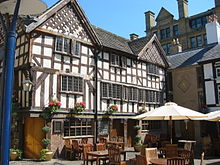 The Old Wellington Inn, Manchester
The Old Wellington Inn, Manchester
- The Bitter End, Cockermouth, situated in the ancient and historic Kirkgate area of the "Gem" town and home of the smallest brewery in Cumbria.
- The Philharmonic Dining Rooms, Liverpool ('The Phil'). Grade II listed Victorian pub with Art Deco lighting and mosaic floor and bar. Once much favoured by the Liverpool Poets.
- The Scotch Piper, Lydiate, Merseyside is the oldest Pub in the traditional county of Lancashire
- The Cat and Fiddle Inn in Cheshire is the second-highest inn or public house in England.
- Ye Olde Man and Scythe is one of the oldest pubs in the country, and the oldest in Bolton, dating back to 1251
- The Moon Under Water, Deansgate, Manchester, a Wetherspoons house, is the largest in the country
- The Old Wellington Inn, Shambles Square, Manchester. The birthplace of the writer John Byrom and along with its neighbour, Sinclair's Oyster Bar, probably one of the only two pubs in the world to have been physically moved twice. They were both raised 4 ft 9 inches in the 1970s to be incorporated into a redevelopment and then dismantled and re-erected in a new location after the IRA 1996 Manchester bombing.[1]
- Boar's Head, Standish, Greater Manchester has been serving beer since 1271. The pub features in the Domesday Book. During the 15th century it was the overnight inn for prisoners being transported to Lancaster Prison. It survived intact whilst the English Civil War Battle of Wigan Lane was taking place nearby.
South East England
- The Hole in the Wall, Brighton, claims to be the smallest pub in Britain, with a certificate stating this fact on the wall.
- Evening Star, Brighton, birthplace of the Dark Star Brewery.
- The John Brunt V.C., Paddock Wood, is the only pub in the country to be named after a holder of the Victoria Cross
- The King's Head, Aylesbury, the oldest pub with a coaching yard in the south of England and one of only two pubs in England run by the National Trust
- Ye Olde Fighting Cocks, St Albans, Hertfordshire. Considered to be the oldest pub in Britain (8th century) by the Guinness Book of Records. Claim disputed by other establishments who maintain that the inn was entirely rebuilt in 1485, not quite in the same location.
- The Royal Standard of England, Beaconsfield, Buckinghamshire named for The Royal Standard (United Kingdom) and situated in Forty Green, claims to have evolved from an Anglo-Saxon alehouse, an ordinary domestic house in which people were allowed to come into the kitchen or front room to drink.
- The Seven Stars Inn, Robertsbridge, East Sussex, oldest pub in the Harveys Brewery stable, built in the 14th century on the main road north of Hastings, and said to be haunted.
- Stag Inn, Hastings, East Sussex.
South West England
- The Red Lion, Avebury, Wiltshire. The only pub in the world inside a stone circle.
- Jamaica Inn, Bolventor, Bodmin Moor, Cornwall. Location of the 1936 novel Jamaica Inn by Daphne du Maurier, made into the film Jamaica Inn by Alfred Hitchcock in 1939.
- The Top House, Lizard, Cornwall. The most southerly pub in the UK (ignoring the Turk's Head on St Agnes, Isles of Scilly)
- The George Inn, Norton St Philip, Somerset. Built in the 14th or 15th century as a wool store for the priory at Hinton Charterhouse. Later used as army headquarters, during the Monmouth Rebellion in 1685, and a courtroom by Judge Jeffreys as part of the Bloody Assizes.
- The Warren House Inn is a remote and isolated public house in the heart of Dartmoor, Devon. It is the highest pub in southern England at 1,425 feet (434 m) above sea level. It is located on an ancient road across the moor, about 2 miles (3 km) north east of the village of Postbridge and has been a stopping point for travellers since the middle of the 18th century.
- Bristol
- The Llandoger Trow, Bristol. Robert Louis Stevenson’s inspiration for the Admiral Benbow in Treasure Island.
- The Old Duke, Bristol. Jazz and Blues venue dating from about 1780.
- King William and Naval Volunteer Public Houses, Bristol. Dating from 1670.
- Black Castle Public House, Bristol. Built in 1745—1755 as a folly sham castle from pre-cast black copper-slag blocks from a foundry.
- The Coronation Tap. Has existed under that name for at least two hundred years.
- Hatchet Inn, Bristol, Bristol from 1606.
- Mauretania Public House, Bristol. Includes some of the furnishings from the RMS Mauretania.
- Nova Scotia, Bristol. Situated on Spike Island adjacent to the Cumberland Basin in Bristol Harbour.
- Old Post Office, Bristol. Built in 1746.
- Palace Hotel, Bristol. Built in 1869. Its exterior ornamentation includes two Assyrian-style hermai.
- Printers Devil, Bristol.
- Pump House, Bristol. Built around 1870 by Thomas Howard as a Hydraulic Pumping House to provide power to the bridges and machines of Bristol Harbour.
- Seven Stars Public House, Bristol. Built in the 17th century.
- Shakespeare Inn, Bristol. Dating from 1636.
- Shakespeare Public House, Bristol. Dating from 1725.
- Stag and Hounds Public House. Dating from 1483.
- The Crown, Bristol. Built in the 18th century.
- The Victoria, Clifton, Bristol. Originally a part of the much larger historic Lido, the corner was sold off to create the pub in 1851, in order to raise funds to help complete the development.
Southern England
- The Bat & Ball Inn, Clanfield, Hampshire. Next to the 'Cradle of Cricket' at Broadhalfpenny Down.
- The Bear Inn, Oxford, dates back to 1242.
- The Eagle and Child in Oxford (frequented by The Inklings, a writing circle that included J. R. R. Tolkien and C. S. Lewis)
- The Lamb & Flag, Oxford
- The Turf Tavern, Oxford, where former U.S. president Bill Clinton "did not inhale" marijuana.
- The Red Lion, Southampton, a very old timber-beamed pub where King Henry V tried traitors to the crown in 1415 on the eve of his departure to France.
- The Winkle public house, in Winklebury, Basingstoke, Hampshire is the only pub with that name in the UK.[citation needed]
West Midlands
- The Adam & Eve, a public house in Deritend dating back to at least 1801.
- The Crooked House (officially called The Glynne Arms), Himley, Dudley, Staffordshire. Not a metaphor - due to mining subsidence, the inn began to fall into a hole in the early 19th century, but was saved by buttressing. It has retained its dizzying tilt ever since.
- The Old Crown, Birmingham. One of the oldest buildings in the city and the oldest pub in the city, dating back to 1368.
- The Nag's Head, Burntwood. Though the current building is more recent, there has been a pub on the site since before the Domesday Book was written.
- The Lad in the Lane (formerly known as the Green Man), Erdington, Birmingham. Though reconstructed at a later date, some of the beams are said to date to the 13th century.
- The Leopard, in Burslem, Stoke-on-Trent. Once referred to as "The Savoy of the Midlands", it was frequented by notable people such as Charles Darwin. Famous as the place where Josiah Wedgwood and James Brindley met to discuss building the Trent and Mersey Canal in 1765. It is locally believed to be haunted, having appeared on the television programme Most Haunted Live and has many interesting features, including tunnels leading from the cellars to the old prison cells underneath the old town hall, and over 50 original Victorian hotel bedrooms.
Shropshire[2]
There are currently 640 pubs in the county; the notable ones are listed below:
- All Nations, Madeley
- Anchor, Anchor
- Armoury, Shrewsbury
- Boat, Jackfield
- Black Boy, Bridgnorth
- Bull Hotel, Ludlow
- Castle Hotel, Bishop's Castle
- Charlton Arms Hotel, Ludlow
- Church Inn, Ludlow
- Coalbrookdale Inn, Coalbrookdale
- Cock Hotel, Wellington
- Golden Cross Hotel, Shrewsbury
- King's Head, Shrewsbury
- Kremlin, Clee Hill Village
- Loggerheads, Shrewsbury
- Mytton and Mermaid, Atcham
- Nag's Head, Shrewsbury
- Railway Inn, Yorton
- Railwayman's Arms, Bridgnorth
- Red Lion, Ellesmere
- Royal Oak, Cardington
- Salopian Bar, Shrewsbury
- Six Bells, Bishop's Castle
- Sun, Clun
- Sun, Corfton
- Three Fishes, Shrewsbury
- Three Tuns, Bishop's Castle
- Wheatsheaf, Ludlow
- White Horse, Clun
Yorkshire
See also List of pubs in Sheffield
- The Tan Hill Inn in Yorkshire is the highest inn in England at 1,732 feet (528 m) above sea level. Tan Hill is a high point on the Pennine Way. It also won the right to continue to call its Christmas dinner a "family feast", which Kentucky Fried Chicken had registered as a trademark.
- The Old Queen's Head, opened as a public house in the mid-19th century, but is one of the oldest Grade II* listed buildings in Sheffield, dating from around 1475.
- Ye Olde White Harte in Kingston upon Hull, the home of 'The Plotting Parlour' where it was decided not to allow King Charles I into the city, supposedly starting the English Civil War in 1642.
- The Bingley Arms, claiming to be the oldest recorded inn in Britain[3], located in the small village of Bardsey, West Yorkshire.
- The Golden Slipper, Monkgate, York, so called because it was built on the site of a Viking settlement and contains a glass case with the almost perfectly preserved remains of a Viking shoe found on the site.
- The Kelham Island Tavern, Sheffield, is the only pub to have won CAMRA's National Pub of the Year award twice in a row[4]
Northern Ireland
- See Category:Public houses in Northern Ireland
Scotland
- See Category:Public houses in Scotland
Wales
- See Category:Public houses in Wales
See also
- Pub names
- Category:Public houses in England
References
Notes
- ^ http://www.manchester2002-uk.com/buildings/squares/manchester-squares.html Retrieved 2007-12-30
- ^ Shropshire Pub Survey
- ^ http://www.bingleyarms.co.uk/history.php
- ^ Yorkshire pub judged 'Best in Britain' -, Campaign for Real Ale, 17 February 2010, http://www.camra.org.uk/page.aspx?o=a315563, retrieved 2011-04-20
External links
- Portsmouth Pubs website
- Pub Review Website: Account currently suspended as at 1 August 2010
- The Guide to London Pubs
- The Lost Pubs Project: Lost and closed pubs of the UK.
- Old Pubs of Reading: A catalog of old pubs in Reading, Berkshire.
Categories:- Public houses in the United Kingdom
Wikimedia Foundation. 2010.

